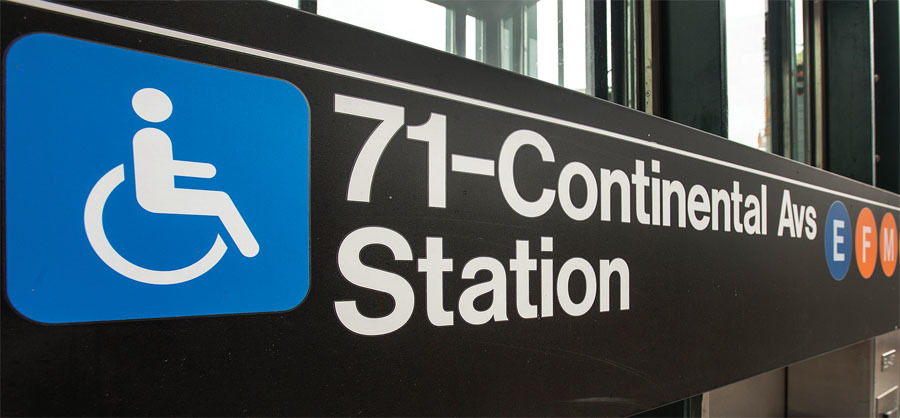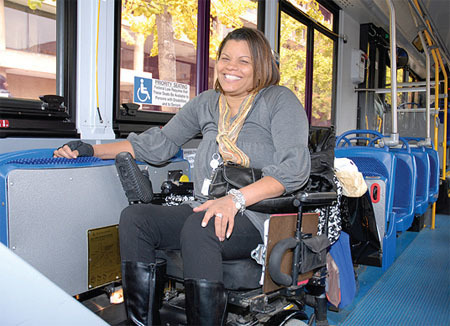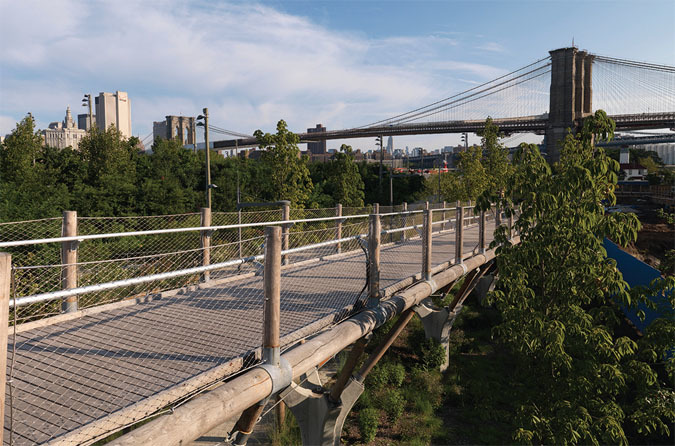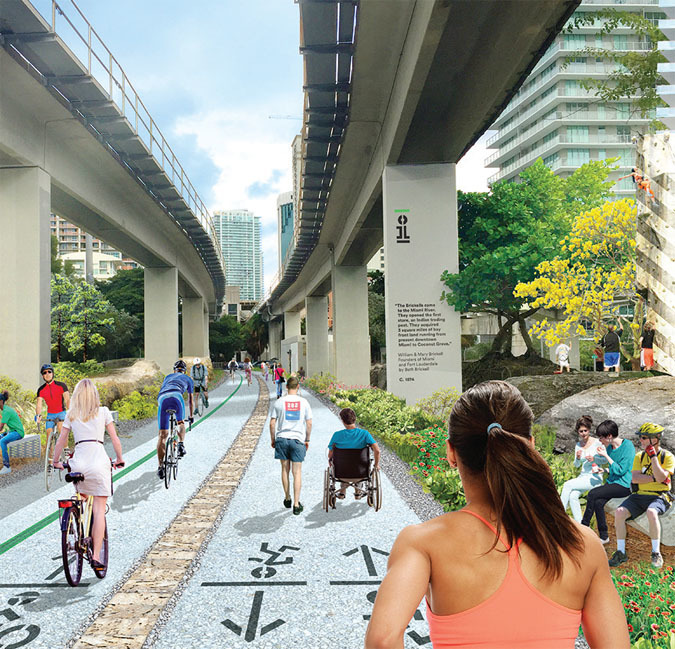ON COMMON GROUND: Universal Design & Inclusive Mobility
05/18/2018

You’ve just moved into your new home. In addition to guiding you through the offer/ counter offer, financing, inspection and closing — your enlightened REALTOR® has found a dwelling that meets your needs as a person with a physical disability.
There’s at least one level entrance, wider doorways, a modified bathroom with a roll-in shower, raised commode with safety grab bars and a sink you can roll up to from a wheelchair. Though it has taken a ton of research, only half the battle is won. The inside of the home you purchased might be a show case of barrier-free access, but what about your neighborhood? Is there a nearby commuter train or major bus route? Are they accessible? Can you get to them safely via wide sidewalks and pedestrian-friendly crosswalks? Is the neighborhood park readily accessible, or filled with barriers?
For a person with a disability — and according to the U.S. Census, there are 57 million disabled Americans — nothing is more relevant to quality of life than the old real estate adage “location, location, location.” But savvy REALTORS® know that location does not mean merely good schools, low crime and rising real estate values. When serving a client with a mobility impairment — and 16 million Americans use wheelchairs, canes, crutches, or walkers for mobility — a real estate professional should be familiar with the concepts of Universal Design and Inclusive Mobility.
Universal Design is defined as: “The design of products and environments to be usable by all people, to the greatest extent possible, without the need for adaptation or specialized design.” The concept was developed by the late architect Ronald L. Mace, founder of the Center for Universal Design at North Carolina State University. The beauty is that Universal Design is not some segregated approach only relevant to wheelchair users. Its principles make spaces welcoming and easy to use for elderly people, young children, parents pushing strollers and others.
Inclusive Mobility is an approach to designing the public realm in a way that is accessible to all people — from the moment they leave their door until they arrive at their destination: work, school, the supermarket, the park, shops, etc. The approach combines increased pedestrian access and safety with barrier-free public transit. Complete Streets is the concept that the roadway should not be designed primarily for cars — with mobility for pedestrians, bicyclists, transit riders and others merely an afterthought. Complete Streets — a rapidly-growing concept in the planning and transportation fields — advocates for calmed traffic, wide sidewalks, dedicated bike lanes, safe crosswalks, curb ramps for disabled folks and well-defined transit stops, ideally with shelters to protect all riders from the elements.
Inclusive Mobility extends to public transit, which is especially important to commuters in larger cities where traffic congestion is doubling and tripling commute times. Although the Americans with Disabilities Act (ADA) has been federal civil rights law since 1990, transit is far from perfect for people with disabilities. In New York, a city that thrives on subway trains moving millions of people to work, just 117 of its 472 subway stations are fully accessible. Only 67 percent of Chicago’s train stations are fully accessible to people with disabilities. The key is to work with elected officials to retrofit stations. Some communities have gotten meaningful results. Washington D.C.’s 91 Metro train stations are 100 percent accessible.
Even in medium-sized cities, public transit often is the only affordable way for a wheelchair user to get from home to work, college or other crucial destinations. Accessible consumer van upgrades — installing lifts, ramps, safety tie-downs, and automated systems that allow for transfer from a wheelchair to the driver’s seat — can cost upward of $75,000, and thousands more per year to fuel, maintain, insure and park. That makes it cost-prohibitive for low- to moderate-income families and barely attainable to even middle- to upper-income households.


Many government officials embrace ride-share and transportation network companies, like Uber and Lyft, as the solution to the expense of vehicle ownership, traffic congestion and the high cost of adding transit lines. But these app-based services are provided by independent contractors who typically drive sedans and SUVs, meaning virtually no ride share vehicles can accommodate those who use power wheelchairs or other large motorized devices.
Activist John Wetmore produces Perils for Pedestrians, a public affairs series on public access cable television stations in 150 cities in the United States. While the videos are aimed at pedestrian safety for all, Wetmore is acutely aware that something as simple as a public sidewalk full of obstructions can eliminate freedom of mobility for a person with a disability.
“Often those responsible for blocking the sidewalk will say that it is alright because they meet the minimum legally required by the ADA. That is like bragging that you passed because you got a D on your report card,” Wetmore said. “We should expect better than that. Rather than striving for a D, they should attempt to get an A by putting the obstructions entirely out of the sidewalk.”
Wetmore’s companion website has galleries that illustrate bad design examples, such as a parking meter in the middle of a sidewalk, a curb ramp constantly prone to flooding storm water, a street so full of sidewalk café tables that a wheelchair user has no room to maneuver, concrete so damaged and poorly maintained that it blocks wheelers and creates a tripping hazard for all. Another photo shows a streetlight control panel placed in the center of a heavily-traveled sidewalk right where a wheelchair user would crash into it after negotiating a curb ramp.
Along with many blunders, Wetmore highlights an excellent example of a wheelchair-accessible sidewalk in Augusta, Georgia, that meets pedestrian access standards in the PROWAG (Public Right of Way Accessibility Guidelines) under the ADA.
Everything about transportation — both urban and rural — will likely be transformed over the next decade. Transportation service providers such as Uber and Lyft, and autonomous self-driving vehicles are already changing the landscape. Some fear that suburban transit service will disappear altogether.

So what exactly does the future hold, and how do we serve everyone? These are some of the questions that land use and transportation planner Jana Lynott AICP, MA, seeks to answer.
Lynott manages the American Association of Retired Persons’ (AARP) transportation research agenda. She is responsible for the development of AARP’s policy related to transportation and other livable communities issues.
“It’s one thing to understand the law and the regulations, but another to understand the design experience. All of us as planners need to wrap our heads around the principles of universal design and think through what that means,” said Lynott.
Lynott believes that these principles are essential to the design of better, more disability-friendly transit systems. For example, even compliantly designed buses may miss the mark if they service a bus way where poorly designed stops result in bus ramps that must be extended at a steep slope.
Said Lynott: “The devil is in the details with design.”
Lynott believes that if design is to truly be inclusive, it must balance the sexy with the sensible. This applies to developments on the cutting edge, such as self-driving vehicles, like autonomous buses and shuttle buses.
Some of the vehicles currently in beta incorporate hip design details such as papasan, or bowl chairs. But the chic design doesn’t serve all riders.

“An older adult — even one who walks — may have difficulty getting back upright from the seats. Standard transit bus designers have already figured out how to design accessible seating. We shouldn’t forget what we’ve already done that works,” said Lynott.
The National Association of City Transportation Officials (NACTO) has developed “The Transit Street Design Guide” for the development of transit facilities on city streets, and for the design and engineering of city streets to prioritize transit while improving transit service quality for all.
The NACTO guide incorporates universal design features, which are critical throughout the transportation network, making it possible for any street user to comfortably and conveniently reach every transit stop. Universal street design facilitates station access, system equity, and ease of movement for all users, especially people using wheelchairs or mobility devices, the elderly, people with children and strollers, and people carrying groceries or packages.
While clear pedestrian paths, safe crosswalks and public transit that is accessible — via gently-sloped ramps to boarding stations, elevators, or lift-equipped buses — is a key part of the equation, accessible civic space is equally crucial to providing a highly livable community for people with disabilities and their families.
Michael Van Valken burgh Associates placed so much emphasis on Universal Design in its creation of Brooklyn Bridge Park that the park’s website has a prominent link that details all of the accessible features on its piers and greenway that stretches for more than a mile along the East River waterfront.


“Ramped pathways and bridges are less prone to technical difficulties, and they also create a stronger continuity of landscape experience that is part of the enjoyment of being in a park,” said the Van Valkenburgh team. “Once you decide that it is important to connect two spaces through the landscape, it seems worth the effort to make sure that everyone can use it.”
The Van Valkenburgh firm embraces creative approaches to designing for all, opting for landscape-based solutions to accessibility that use gentle slopes instead of lifts or elevators that require more maintenance and are much more likely to break down.


“In some cases, accessibility requirements provide opportunities to build pathways that are more engaging — for instance a curved pathway that directs your views to the landscape context rather than a straight procession with an unchanging perspective,” the Van Valkenburgh team said. “We are strong advocates for building accessibility into the fundamental structure of a project, rather than looking at it as an obligation or an afterthought. Ultimately, the goal is to make accessibility feel effortless so that everyone can enjoy the landscape on the same terms.”
Toronto, Canada-based nonprofit 8 80 Cities has challenged more than 250 cities on five continents to design their streets and public spaces to be easily accessible for both an eight-year-old and an 80-year-old.
“We focus on children and older adults because we know that modern childhood and older adulthood in cities around the world is increasingly characterized by limited freedom and independence, reduced opportunities for social engagement and physical activity in public spaces, and few opportunities to participate in community building and decision-making,” said Amanda O’Rourke, executive director of 8 80 Cities.
She said children, older adults and people with disabilities often have the most to benefit from living in connected, walk able and bike able communities with access to great parks and public spaces.

“One of the famous quotes from our Founder and Chair of the Board Gil Penalosa is ‘we have to stop building our cities as if everyone was 30 years old and athletic,’” O’Rourke said. “Streets often account for at least 25 percent of a city’s public space (in some cities close to 40 or 50 percent) and that means they are spaces that belong to all of us. The way we have designed cities for the last 60 years has been much more focused on the mobility of cars, than on the health and happiness of people. And this car-centric planning has been disproportionately bad for vulnerable road users — children, older adults, people with a disability and low-income communities.”
Chicago’s 25-acre Millennium Park earned a Barrier-Free America Award from the Paralyzed Veterans of America — presented to architect Edward K. Uhlir, executive director of the Millennium Park Foundation.
The park’s original grandiose design featured lots of grand staircases and other elements that were not conducive to Universal Design. The late Uhlir is credited with working with additional designers to greatly increase accessibility via ramps, gentle slopes and barrier-free play areas.
“My office saw (the original plan with grand staircases and other barriers to mobility) and said ‘no way are you going to build a big park in downtown Chicago with stairs that are not accessible to people with disabilities,’” said Denise Arnold, a private practice architect and inclusive design specialist who worked for Chicago’s Mayor’s Office for People with Disabilities while Millennium Park was being developed.
The Crown Fountain, designed by Catalan artist Jaume Plensa and executed by Krueck and Sexton Architects of Chicago, is composed of a black granite reflecting pool placed between a pair of 50-foot glass brick towers that display digital videos on their inward faces.
“The fountain is the coolest thing in the world and (the reflecting pool) has no more than quarter inch lip at any place,” Arnold said of the grand piece of usable public art. “The fountain has giant glass block towers where water spouts 12 feet high off the ground and comes down on kids. It is a completely accessible mini water park. You see people of all abilities running around that fountain and playing in it.”
James Corner Field Operations, the New York-based landscape architecture and urban planning studio that is best known as the project lead for the High Line in Manhattan, has heavily incorporated universal design into the Underline in Miami. The Underline’s vision is to transform 10 miles of land below Miami’s Metrorail into an iconic linear park, world-class accessible urban trail, to be completed by 2022.

“The key criteria for the design of these two primary components are to provide a safe environment for users navigating the trail at different speeds and physical abilities,” says Isabel Castilla, lead designer for the Underline and a senior associate at James Corner Field Operations.
The Underline will replace an underutilized, not universally accessible paved trail known as the M-Path. The existing M-Path is hampered by dozens of street crossings that are very dangerous for wheelchair users, children, and slow-walking pedestrians. Field Operations’ plan will increase safety and improve visibility at intersection crossings, meeting the needs of people with visual, hearing, cognitive, and other impairments, as well as mobility difficulties, Castilla said.
